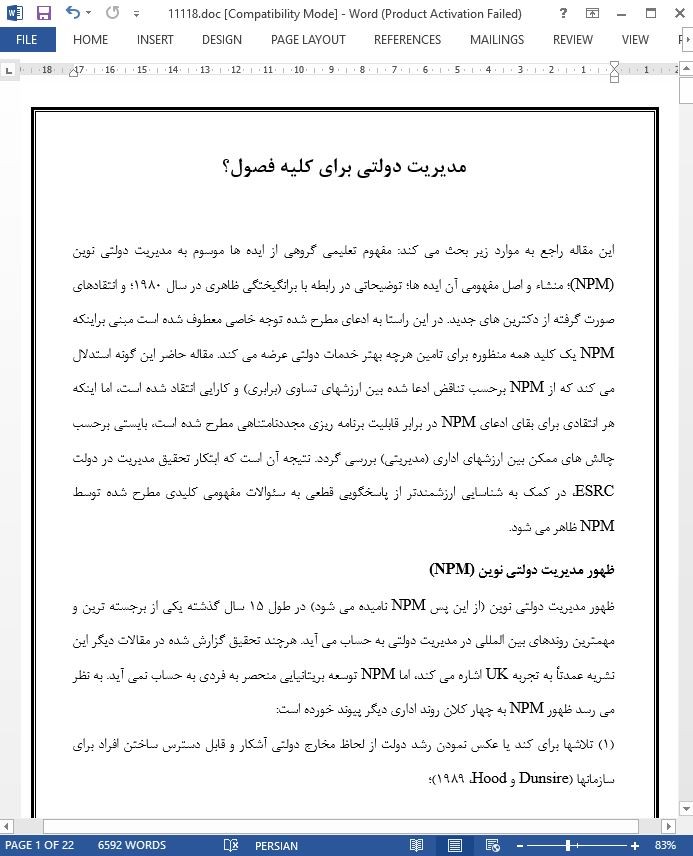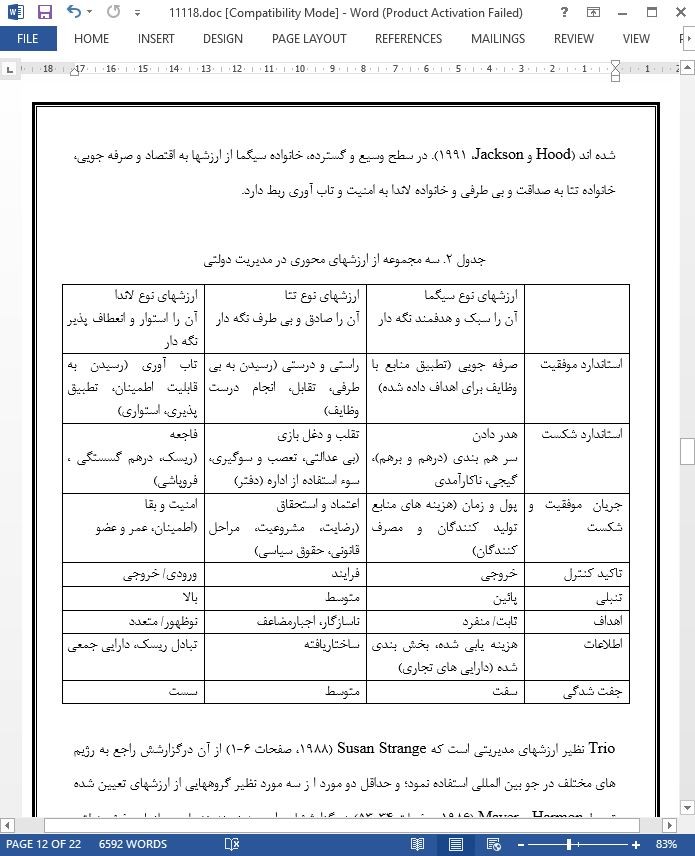
مدیریت دولتی برای کلیه فصول؟
این مقاله راجع به موارد زیر بحث می کند: مفهوم تعلیمی گروهی از ایده ها موسوم به مدیریت دولتی نوین (NPM)؛ منشاء و اصل مفهومی آن ایده ها؛ توضیحاتی در رابطه با برانگیختگی ظاهری در سال 1980؛ و انتقادهای صورت گرفته از دکترین های جدید. در این راستا به ادعای مطرح شده توجه خاصی معطوف شده است مبنی براینکه NPM یک کلید همه منظوره برای تامین هرچه بهتر خدمات دولتی عرضه می کند. مقاله حاضر این گونه استدلال می کند که از NPM برحسب تناقض ادعا شده بین ارزشهای تساوی (برابری) و کارایی انتقاد شده است، اما اینکه هر انتقادی برای بقای ادعای NPM در برابر قابلیت برنامه ریزی مجددنامتناهی مطرح شده است، بایستی برحسب چالش های ممکن بین ارزشهای اداری (مدیریتی) بررسی گردد. نتیجه آن است که ابتکار تحقیق مدیریت در دولت ESRC، در کمک به شناسایی ارزشمندتر از پاسخگویی قطعی به سئوالات مفهومی کلیدی مطرح شده توسط NPM ظاهر می شود.
ظهور مدیریت دولتی نوین (NPM)
ظهور مدیریت دولتی نوین (از این پس NPM نامیده می شود) در طول 15 سال گذشته یکی از برجسته ترین و مهمترین روندهای بین المللی در مدیریت دولتی به حساب می آید. هرچند تحقیق گزارش شده در مقالات دیگر این نشریه عمدتاً به تجربه UK اشاره می کند، اما NPM توسعه بریتانیایی منحصر به فردی به حساب نمی آید. به نظر می رسد ظهور NPM به چهار کلان روند اداری دیگر پیوند خورده است:
(1) تلاشها برای کند یا عکس نمودن رشد دولت از لحاظ مخارج دولتی آشکار و قابل دسترس ساختن افراد برای سازمانها (Dunsire و Hood، 1989)؛
مبانی مدیریت دولتی نوین
کار ESRC Management in Government Initiative به ما کمک کرده است تا اشکال ویژه NPM در UK را شناسایی و تاریخچه اش را ردیابی کنیم. اما، همانند بسیاری از ابتکارات پژوهشی، در ترویج سئوالات بحرانی و حساس، نسبت به پاسخگویی قطعی به آنها موفق تر بوده است. به نظر می رسد دو سئوال کلیدی ارزش بررسی بیشتر را دارند تا به این ترتیب NPM به لحاظ فکری در جایگاهش قرار بگیرد.
اولاً، NPM را می توان به عنوان بیانی از ارزشهای نوع سیگما برشمرد. ادعاهایش عمدتاً در جهت کاهش هزینه ها و عمل بیشتر و حرف کمتر در نتیجه مدیریت با کیفیت بهتر و طراحی ساختاری متفاوت هدایت شده اند. از اینرو، یکی از آزمون های کلیدی موفقیت NPM، تحویل (چگونگی تحویل) آن ادعا، و به نتیجه رسیدن برحسب پذیرش بدیعی است.
Abstract
This article discusses: the doctrinal content of the group of ideas known as ‘new public management’(NPM); the intellectual provenance of those ideas; explanations for their apparent persuasiveness in the 1980 s; and criticisms which have been made of the new doctrines. Particular attention is paid to the claim that NPM offers an all‐purpose key to better provision of public services. This article argues that NFM has been most commonly criticized in terms of a claimed contradiction between ‘equity’ and ‘efficiency’ values, but that any critique which is to survive NPM's claim to ‘infinite reprogrammability’ must be couched in terms of possible conflicts between administrative values. The conclusion is that the ESRC'S Management in Government’ research initiative has been more valuable in helping to identify rather than to definitively answer, the key conceptual questions raised by NPM.
THE RISE OF NEW PUBLIC MANAGEMENT (NPM)
The rise of 'new public management' (hereafter NPM) over the past 15 years is one of the most striking intemational trends in public administration. Though the research reported in the other papers in this issue refers mainly to UK experience, NPM is emphatically not a uniquely British development. NPM's rise seems to be linked with four other administrative 'megatrends', namely: (i) attempts to slow down or reverse govemment growth in terms of overt public spending and staffing (Dunsire and Hood 1989);
IMPLICATIONS FOR NEW PUBLIC MANAGEMENT
The work of the ESRC's Management in Government Initiative has helped us to identify the specific forms that NPM took in the UK and to trace its history. But, like many research initiatives, it has perhaps been more successful in prompting the critical questions rather than in answering them definitively. Two key questions in particular seem to deserve more examination, in order to 'put NPM in its place' intellectually.
First, NPM can be imderstood as primarily an expression of sigma-type values. Its claims have lain mainly in the direction of cutting costs and doing more for less as a result of better-quality management and different structural design. Accordingly, one of the key tests of NPM's 'success' is whether and how it has delivered on that claim, in addition to succeeding in terms of rhetorical acceptance. We still have remarkably little independent evidence on this point, and work by Dimsire et al. (1988) has some path-breaking qualities in that it is a serious attempt to develop indicators of organizational structure and control systems in a way that helps us to understand how privatization and corporatization works.
ظهور مدیریت دولتی نوین (NPM)
امپراتور چه چیزی به تن می کند: دکترین های NPM
طرح آن از کجا آمد: NPM به عنوان وصلت مخالفین
چرا NPM محبوب شد: عامل پذیرش
یک جامه همه منظوره؟ ادعای NPM در مورد عمومیت (فراگیری)
ادعاهای متقابل: منتقدین NPM
سه خوشه از ارزشهای اداری
مبانی مدیریت دولتی نوین
THE RISE OF NEW PUBLIC MANAGEMENT (NPM)
WHAT THE EMPEROR WAS WEARING: THE DOCTRINES OF NPM
WHERE THE DESIGN CAME FROM: NPM AS A MARRIAGE OF OPPOSITES
WHY NPM FOUND FAVOUR: THE ACCEPTANCE FACTOR
AN ALL-PURPOSE GARMENT? NPM's CLAIM TO UNIVERSALITY
COUNTER-CLAIMS: CRITICS OF NPM
THREE CLUSTERS OF ADMINISTRATIVE VALUES
IMPLICATIONS FOR NEW PUBLIC MANAGEMENT
- اصل مقاله انگلیسی با فرمت ورد (word) با قابلیت ویرایش
- ترجمه فارسی مقاله با فرمت ورد (word) با قابلیت ویرایش، بدون آرم سایت ای ترجمه
- ترجمه فارسی مقاله با فرمت pdf، بدون آرم سایت ای ترجمه



